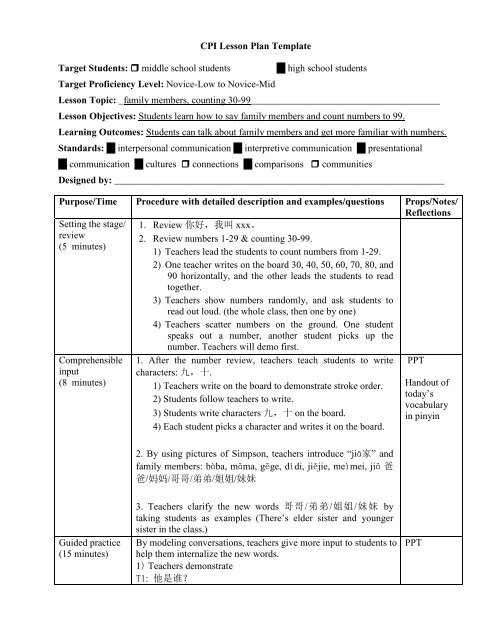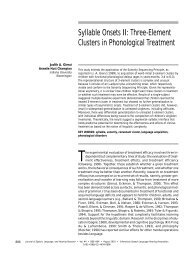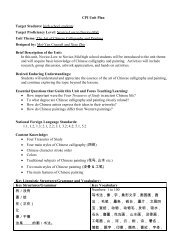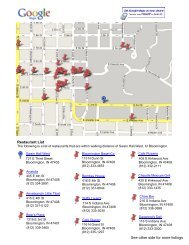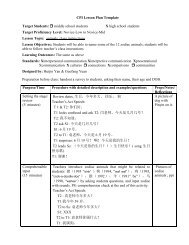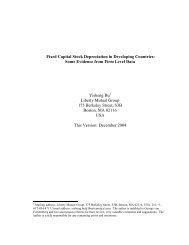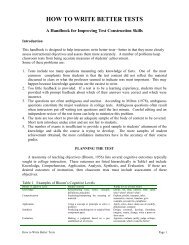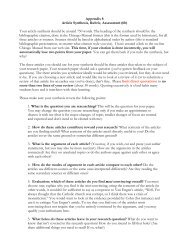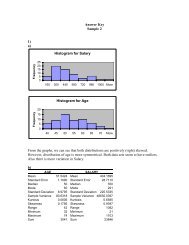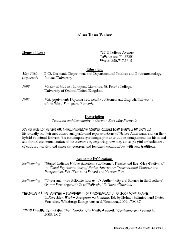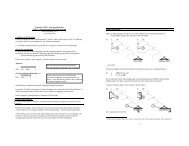Understanding by Design: Sample Lesson
Understanding by Design: Sample Lesson
Understanding by Design: Sample Lesson
You also want an ePaper? Increase the reach of your titles
YUMPU automatically turns print PDFs into web optimized ePapers that Google loves.
Target Students: middle school students<br />
CPI <strong>Lesson</strong> Plan Template<br />
Target Proficiency Level: Novice-Low to Novice-Mid<br />
high school students<br />
<strong>Lesson</strong> Topic: _family members, counting 30-99_______________________________________<br />
<strong>Lesson</strong> Objectives: Students learn how to say family members and count numbers to 99.<br />
Learning Outcomes: Students can talk about family members and get more familiar with numbers.<br />
Standards: interpersonal communication interpretive communication presentational<br />
communication cultures connections comparisons communities<br />
<strong>Design</strong>ed <strong>by</strong>: ____________________________________________________________________<br />
Purpose/Time Procedure with detailed description and examples/questions Props/Notes/<br />
Reflections<br />
Setting the stage/ 1. Review 你 好 , 我 叫 xxx。<br />
review<br />
2. Review numbers 1-29 & counting 30-99.<br />
(5 minutes)<br />
1) Teachers lead the students to count numbers from 1-29.<br />
2) One teacher writes on the board 30, 40, 50, 60, 70, 80, and<br />
90 horizontally, and the other leads the students to read<br />
together.<br />
3) Teachers show numbers randomly, and ask students to<br />
read out loud. (the whole class, then one <strong>by</strong> one)<br />
4) Teachers scatter numbers on the ground. One student<br />
speaks out a number, another student picks up the<br />
number. Teachers will demo first.<br />
Comprehensible<br />
input<br />
(8 minutes)<br />
1. After the number review, teachers teach students to write<br />
characters: 九 , 十 .<br />
1) Teachers write on the board to demonstrate stroke order.<br />
2) Students follow teachers to write.<br />
3) Students write characters 九 , 十 on the board.<br />
4) Each student picks a character and writes it on the board.<br />
2. By using pictures of Simpson, teachers introduce “jiā 家 ” and<br />
family members: bàba, māma, gēge, dìdi, jiějie, meìmei, jiā 爸<br />
爸 / 妈 妈 / 哥 哥 / 弟 弟 / 姐 姐 / 妹 妹<br />
PPT<br />
Handout of<br />
today’s<br />
vocabulary<br />
in pinyin<br />
Guided practice<br />
(15 minutes)<br />
3. Teachers clarify the new words 哥 哥 / 弟 弟 / 姐 姐 / 妹 妹 <strong>by</strong><br />
taking students as examples (There’s elder sister and younger<br />
sister in the class.)<br />
By modeling conversations, teachers give more input to students to<br />
help them internalize the new words.<br />
1) Teachers demonstrate<br />
T1: 他 是 谁 ?<br />
PPT
T2: 他 是 Simpson 的 爸 爸 。<br />
T1: 他 今 年 多 大 ?<br />
T2: 他 今 年 40 岁 。<br />
T1: 他 是 美 国 人 吗 ?<br />
T2: 是 的 。 他 是 美 国 人 。<br />
2) Teacher-student question (Simpson)<br />
T: 她 是 谁 ?/ 她 今 年 多 大 ?/ 她 是 美 国 人 吗 ?/ 他 是 你 的 朋 友 吗 ?<br />
3) pair work: (Teachers model first, and then ask one student, so as<br />
to make instructions clear.)<br />
A: 你 今 年 多 大 ?<br />
B: 我 今 年 _____ 岁 。 你 今 年 多 大 ?<br />
A: 我 今 年 _____ 岁 。 我 是 _________. ( 哥 哥 / 弟 弟 / 姐 姐 / 妹 妹 )<br />
B: 我 是 _________.( 哥 哥 / 弟 弟 / 姐 姐 / 妹 妹 )<br />
Application and<br />
extension<br />
(15 minutes)<br />
Teachers extend the family topic <strong>by</strong> introducing 孩 子 , 和 , 有 ,<br />
没 有 ,and language forms of 你 有 哥 哥 吗 ? 几 个 ? 你 家 有 几 个<br />
人 ?(Simpson & a Chinese family)<br />
1. Teachers demo: 爸 爸 和 妈 妈 有 三 个 孩 子 。<br />
有 / 没 有 哥 哥<br />
有 几 个 哥 哥 ?<br />
2. Pass questions:<br />
你 有 哥 哥 / 弟 弟 / 姐 姐 / 妹 妹 吗 ?<br />
The whole class do it twice. The second time will be faster.<br />
PPT<br />
Paper house<br />
(Toy: Potato<br />
heads)<br />
Assessment and<br />
wrap-up<br />
(5 minutes)<br />
3. Students talk about their own families.<br />
Teachers give each student a folded “ paper house” with 爸 爸 , 妈<br />
妈 , 哥 哥 , 弟 弟 , 姐 姐 , 妹 妹 . Students talk about their families<br />
with a partner.<br />
(Plan B: Teachers use potato heads to assess their performance.<br />
Each student will get a chance to introduce one of their family<br />
members with potato heads.)<br />
1. Culture extension: one-child policy in China.<br />
2. Review characters from one to then. Students write them on the<br />
board.<br />
Homework/<br />
preview<br />
(2 minutes)<br />
Each student gets a homework sheet with two questions and<br />
vocabulary list.<br />
Homework<br />
sheet
Picture
Handouts 1
Handouts 2
PPT


